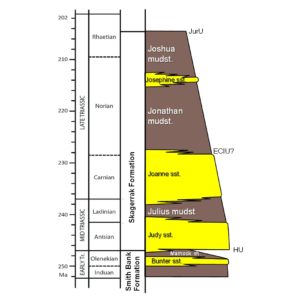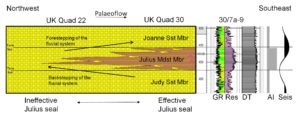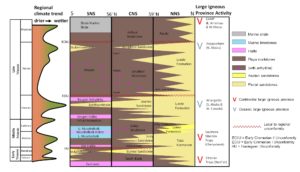BOOKINGS CLOSE AT 17.00 ON 9 MARCH 2021!
9th March 2021
Abstract
Speaker: Dr Stuart Archer, Chief Geologist – Chrysaor
Topic: Recent advances in the North Sea’s Triassic Play
Abstract
The Triassic of the Central North Sea is a continental succession that contains highly prolific hydrocarbon bearing fluvial sandstone reservoirs, partitioned by thick mudstones.
Within the Skagerrak Formation of the UK sector, hydrocarbon accumulations in the Judy, Joanne and Josephine Sandstone members are top sealed by the Julius, Jonathan and Joshua Mudstone members respectively, providing a number of reservoir seal pairs.

However, correlations have been problematical for decades, largely due to biostratigraphic challenges but also due to the non-uniqueness of the lithotypes. Additionally the impact of two Jurassic unconformities and variable TD’s in wells has resulted in many partial penetrations of the Triassic stratigraphy. This talk will summarise recent studies that have shed new light on the stratigraphy and sedimentology in this dryland depositional setting, resolving these historical complexities and in doing so improving correlation power at a regional scale.
Regional correlations have detected lateral facies changes which are important for the seismically mappable extents and resulting palaeogeographies of the mudstones.
Ultimately, these lateral facies changes have implications for the competency of Triassic Mudstone Members as intra-formational top seals. Significant diachroneity is associated with the lithological transitions at member boundaries and although lithostratigraphic surfaces can be used as time-lines over short distances (e.g. within an oilfield), they should not be assumed to represent time-lines over longer correlation lengths.

Climatic trends are interpreted and compared to those of adjacent regions to test the extent and impact of climate change as an allogenic forcing factor on sedimentation. It is suggested that mudstone member deposition (e.g. Julius and Jonathan Mudstone Members) occurred as a result of the retreat of large-scale terminal fluvial systems during a return to more arid ‘background’ climatic conditions. We speculate that the cause of the member scale climatic cyclicity observed within the Skagerrak Formation may be related to volcanic activity in large igneous provinces which triggered the episodic progradation of fluvial systems.

Given that the main stratigraphic uncertainties have been resolved, the focus of applied research needs to change direction to address the main failure criteria in historically unsuccessful exploration wells, namely diagenetic rock quality and lack of charge. This will assist operators to polarise risk, enabling the best prospects to be selected from the remaining Triassic prospect portfolio.
Sponsor
This event is kindly hosted by:

Venue Information
Venue information
Venue name:
Online
Venue address:
This event will be delivered online.

